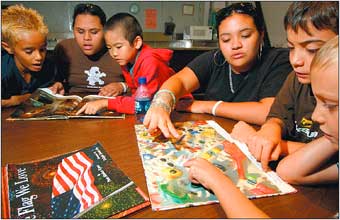 |
| At Connections
Public Charter School on Wednesday, Jazarei
Murphy, third from right, a junior, helps
third-graders Colin Calip and Matthew Cole as they
read one of the "I Spy" series of picture riddle
books. In background, 11th-grader Pomai Padilla,
second from left, reads with third-graders Tama
Mareko and Hua Uehara. - William
Ing/Tribune-Herald
| |
Hilo's newest high school
Connections PCS will graduate its
first class in 2008
by John
Burnett
Tribune-Herald Staff
Writer
With the
beginning of the school year, there are a lot of new faces at
Connections Public Charter School in Hilo. But this year, many
of them are older than in years past.
Connections, the
state's first charter school, has added a high school to go
with its established kindergarten to eighth-grade school.
Connections opened its high school a week ago with 75 ninth
through 11th graders, and will evolve into a four-year high
school next year with about 100 students. Connections has
about 330 students in kindergarten through 11th grade,
according to school Principal John Thatcher.
"We're
trying to develop a small high school that will be a
comprehensive high school where (students) are going to get an
excellent education in a way that kids are not going to just
be going through rote activities, but actually educating them
for their future," Thatcher said. "Abstract thought,
experiences with the real world, experience with governance,
experience with running the school, experiences with teaching
other kids -- the purpose is for the kids to take a leadership
role in how their school is going to be, so it's really their
school. And that's very difficult to do in a large
school."
Connections' high school is headquartered at
Nani Mau Gardens, while their K-8 school is in the Kress
Building at 174 Kamehameha Ave. downtown. CPCS High was
established through the Coalition of Essential Schools' Small
Schools Project, a five-year initiative made possible by an
$18.7 million grant from the Bill & Melinda Gates
Foundation. The aim, according to a statement issued by CES,
is a nationwide network of more than 50 schools which embody
the CES ideal of small, personalized, intellectually vibrant
and equitable learning environments.
"These schools will make a difference in
the lives of children and families who haven't had access to
an intellectually challenging and meaningful high school
education," said Small Schools Project co-director Mara
Benitez in the statement. "Not only will this open up a
lifetime of opportunities for these students but it will also
drive the national conversation around effective school
reform, propelling the small schools movement towards high
quality, intellectually challenging and equitable
schools."
Thatcher said that Connections will receive
about $1,000 per student from the CES Small School Project
grant, as well as technical assistance provided by Harmony
School, a small, private CES mentor school in Bloomington,
Ind.
"This peer-to-peer approach takes advantage of
CES's 20 years of experience in educational innovation to
launch the next generation of exemplary high schools," CES
national Executive Director Lewis Cohen said in the
release.
"One of the reasons this is significant is
that in Hawaii, we have such large high schools," Thatcher
added. "There is 40 years of research that has shown that
large schools are difficult for kids who are socioeconomically
disadvantaged. The quality of education is very difficult to
deliver at a larger school.
CES schools share a common set of beliefs
about the purpose and practice of schooling, known as the "CES
Common Principles." Based on decades of research and practice,
the principles call for all schools to offer personalized
instruction to address individual needs and interests; small
schools and classrooms, where teachers and students know each
other well and work in an atmosphere of trust and high
expectations; multiple assessments based on performance of
authentic tasks; democratic and equitable school policies and
practices; and close partnerships with the school's
community.
"We're really trying to go out into the
community with the kids and to have them involved with
projects," Thatcher explained. "We're trying to work as much
with (the University of Hawaii at Hilo) as we can,
establishing a marine science program. We're trying to get
involved with what we call the 'sustainable industries' on
this island -- agriculture, tourism, marine science,
astronomy. So we really want our kids to get exposure to all
these areas."
Thatcher said that two new teachers have
been hired, with several of Connections' middle school
teachers moved to the high school level. He added that some of
the students are taking a part of their school program via
distance learning using NovaNET by Pearson Digital
Learning.
"It's the same program that many of the high
schools here are using for credit recovery," Thatcher said.
"We're trying to use it for more than credit recovery. There
are some good materials there, so we're having kids use it for
some of their course work. Math is a good example. In high
school, there are a lot of kids whose skill level in math is
all over the place. So if you're trying to teach to kids where
the skill is almost at an individualized level, that's kind of
difficult (in a traditional classroom setting). So this is a
way of getting the kids to work at their skill level, whatever
it might be for them, that will serve their purposes much
better."
John Burnett can be reached at jburnett@hawaiitribune-herald.com.
|

